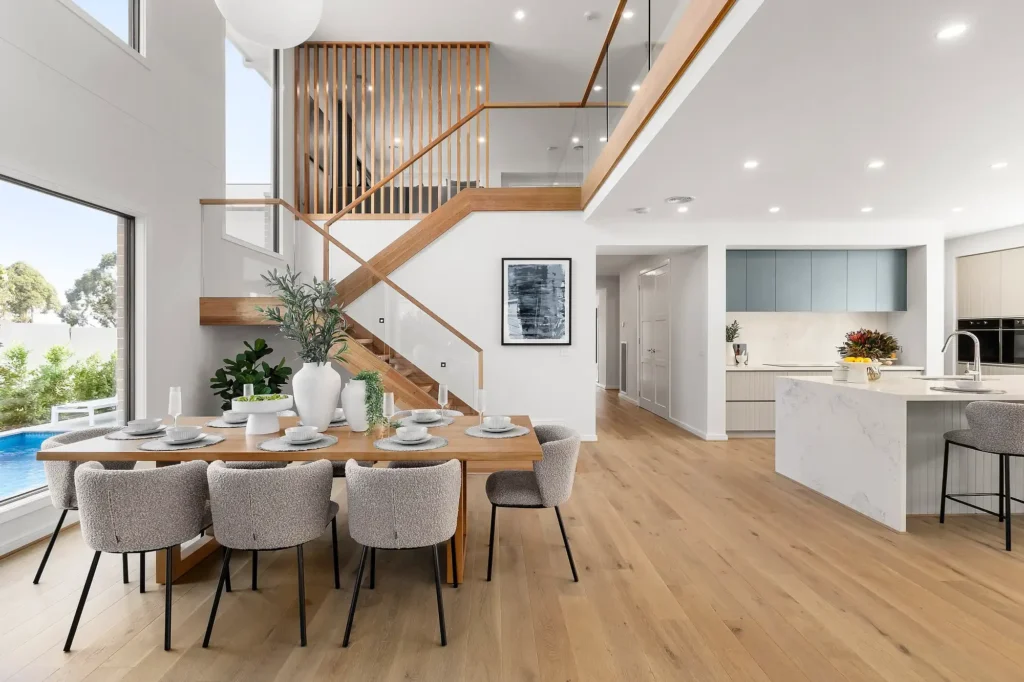Building a project home doesn’t mean you have to sacrifice personality or blow the budget on loads of customisations. There are certain choices worth investing in that can have a big impact on your space.
Project homes are the most popular type of residential build in Australia thanks to their affordability and efficient timelines. Made by volume builders, project homes are typically built using pre-designed plans and fixed pricing.
Unlike custom homes, project homes operate within a more structured framework, with “controlled choices,” to achieve their timelines and stick to budgets, explained Sherridon Homes Interior Designer Manager, Samantha Darmarkis.
“Within the volume model, you’ve got to have some constraints because builders have their set agreements with the suppliers, [so] there are set designs, and it’s about working within those parameters,” Darmarkis explained.
“Volume builders definitely do allow clients to customise, but it’s different to building with a custom builder where anything goes.”
MORE: Six builders offering affordable and charming Hamptons-style homes

When going through options for flooring or tiling with a project builder, for example, customers would be shown all inclusions for that category, but also be shown other options in higher-priced categories.
“From what was included in the house to where they could potentially take it, there’s a fair bit of scope. So I think that does help people sit in the parameters of their budget,” Darmarkis said.
But which are the customisations worth spending on? These are her suggestions for tweaks that offer value for money and can make your project home feel like your own.
1. Floor and wall material choices
Choosing durable and long-lasting floor coverings can significantly impact the overall feel and value of your home.
“Often, what is included in the home will be at the lower price point. It’s not that it’s an inferior product, but I think there’s plenty of room to look at things that maybe have more longevity,” Darmarkis said.
“Even if it gives you more choices with colour and texture, floor coverings cover such a large span of the home and you notice them in many areas.”

MORE: Design tips that will make your bathroom a dream to maintain
This logic also applies to full wall tiling in wet areas. Instead of just tiling around vanities, sinks, showers, and baths, tiling all the walls can offer a more luxurious feel.
“It almost gives you a hotel experience and it doesn’t have to be an expensive tile to achieve that,” Darmarkis said.
But an all-tile choice is also incredibly helpful from a long-term cleaning and maintenance perspective.
“Doing full tiling makes a difference in the long run with children and pets as well.”
2. Lighting choices
Lighting design can significantly impact the atmosphere and feel of your home, and it’s best to consider placement and lighting types early in the process.
This can be especially important for two-storey houses, according to Darmakis.
“In double-storey homes, additional downlights and feature lighting can be tricky to add later,” she said.
When planning your lighting design, it’s good to think about feel, but also functionality. Kitchens, for example, need ample lighting as it is ultimately a workspace, but after meal prep you may want the option for a little mood lighting.
Dimmers and LED strip lighting can be excellent additions for this purpose, allowing you control over light intensity, especially in kitchen and living areas. It’s also helpful for bathrooms (so you don’t need overhead lights for a quick midnight dash).
“It’s important to review and think, ‘How do the lights feel there? Is it enough lighting? Would they love some feature elements?’,” asked Darmakis.
“It can make a difference to the overall feel of the home and once again, doesn’t have to be hugely expensive to add some additional lighting.”
3. Storage solutions
Ensuring there’s enough storage in your home from the outset can avoid clutter and make daily living more functional and convenient.
“Looking into doing some joinery – because that’s purpose-designed for the space – can end up having a better outcome with storage allocation,” Darmarkis explained.
Other solutions are built-in or walk-in wardrobes and linen cabinets, which can maximise the usability and aesthetics of your living spaces from the get-go.
4. Butler’s pantries
As Australian families increasingly embrace multi-generational living, butler’s pantries are becoming more popular among homebuyers, as they offer essential overflow for the main kitchen and double as a useable storage area, keeping mess contained.

MORE: Why the kitchen is the most important room in the house
“It’s not just having the big walk-in pantry, it’s almost like a mini version of their main kitchen,” Darmarkis said.
“It could have a secondary dishwasher, another sink and even sometimes people put an additional oven in there.”
5. Energy efficient appliances
With new homes having to meet minimum energy ratings, customisations to maximise energy efficiency are worth the money as they offer savings over the longer term but also future proof your home.
“With some of the new regulations and the way we’re going by phasing out gas eventually, people are becoming a bit more savvy in that space and as a builder, we’re moving into that space as well,” Darmarkis said.
“People might want to extend on that further in terms of the offering and what’s included. They might want even more energy efficient options so that they’re on the front foot of [climate considerations] as well.”
Big-impact customisations that can wait
Homeowners can defer less critical upgrades – upgrades that aren’t required in the build planning stage – to further personalise their home down the track when budget permits.
“That could be windows, furnishings, painted walls and wallpaper,” Darmarkis explained. “Homeowners could get lots of quotes themselves later and don’t have to do that with the builder.”
Furnishings like wallpaper, art and curtains, and fittings like tapware and even windows, have a major impact on the character of your space and can be easily changed later down the track when you’ve saved more. You can then take your time to find something bespoke or that distils your personal style.
“Those features can make quite a bit of impact and really personalise homes.”
Looking for a home builder? Check out our dedicated New Homes building section.
The post Project home customisations worth spending your money on appeared first on realestate.com.au.

